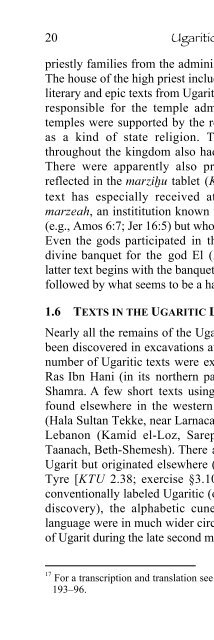A Primer on Ugaritic: Language, Culture, and Literature - enenuru
A Primer on Ugaritic: Language, Culture, and Literature - enenuru
A Primer on Ugaritic: Language, Culture, and Literature - enenuru
Create successful ePaper yourself
Turn your PDF publications into a flip-book with our unique Google optimized e-Paper software.
20<br />
<strong>Ugaritic</strong> <str<strong>on</strong>g>Primer</str<strong>on</strong>g><br />
priestly families from the administrative texts excavated at Ugarit.<br />
The house of the high priest included a significant repository of the<br />
literary <strong>and</strong> epic texts from Ugarit (see Figure 1.4, #2). Priests were<br />
resp<strong>on</strong>sible for the temple administrati<strong>on</strong> <strong>and</strong> services. These<br />
temples were supported by the royal palace <strong>and</strong> may be regarded<br />
as a kind of state religi<strong>on</strong>. The numerous villages scattered<br />
throughout the kingdom also had their local shrines <strong>and</strong> priests.<br />
There were apparently also private religious associati<strong>on</strong>s, as<br />
reflected in the marzih˙u tablet (KTU 3.9; see exercise §5.3). This<br />
text has especially received attenti<strong>on</strong> because of the biblical<br />
marzeah, aninstitituti<strong>on</strong> known throughout the ancient Near East<br />
(e.g., Amos 6:7; Jer 16:5) but whose significance is much debated. 17<br />
Even the gods participated in this instituti<strong>on</strong>, as we see in the<br />
divine banquet for the god El (KTU 1.114; exercise §6.1). This<br />
latter text begins with the banqueting myth (obverse), which is then<br />
followed by what seems to be a hangover remedy (reverse).<br />
1.6 TEXTS IN THE UGARITIC LANGUAGE<br />
Nearly all the remains of the <strong>Ugaritic</strong> language <strong>and</strong> literature have<br />
been discovered in excavati<strong>on</strong>s at the site of Ras Shamra. A small<br />
number of <strong>Ugaritic</strong> texts were excavated at the small port site of<br />
Ras Ibn Hani (in its northern palace), 5 kilometers south of Ras<br />
Shamra. A few short texts using a cuneiform alphabet have been<br />
found elsewhere in the western Mediterranean area <strong>on</strong> Cyprus<br />
(Hala Sultan Tekke, near Larnaca), in Syria (Tell Sukas, Kedesh),<br />
Leban<strong>on</strong> (Kamid el-Loz, Sarepta), <strong>and</strong> Israel (Mount Tabor,<br />
Taanach, Beth-Shemesh). There are also texts that were found at<br />
Ugarit but originated elsewhere (like the letter from the king of<br />
Tyre [KTU 2.38; exercise §3.10]). Thus, while the language is<br />
c<strong>on</strong>venti<strong>on</strong>ally labeled <strong>Ugaritic</strong> (owning to the circumstance of the<br />
discovery), the alphabetic cuneiform script <strong>and</strong> the “<strong>Ugaritic</strong>”<br />
language were in much wider circulati<strong>on</strong> than simply the kingdom<br />
of Ugarit during the late sec<strong>on</strong>d millennium. This also points to the<br />
17<br />
For a transcripti<strong>on</strong> <strong>and</strong> translati<strong>on</strong> see T. Lewis, “El’s Divine Feast,” in UNP,<br />
193–96.


